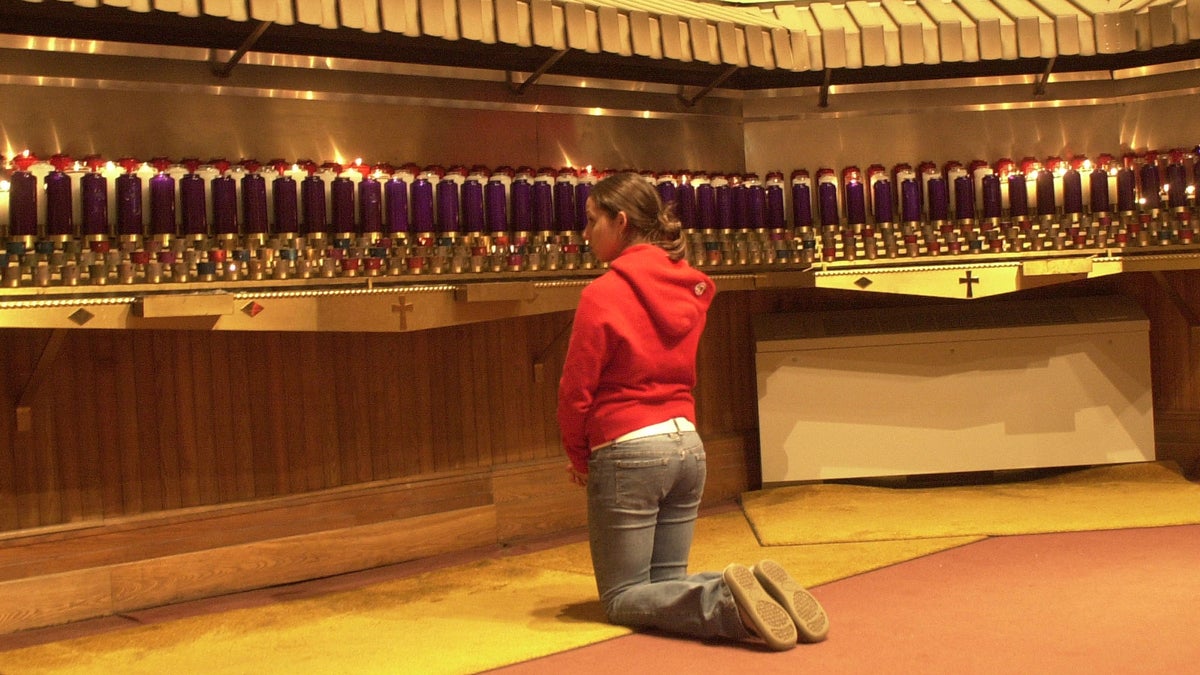Keeping the old faith in a new way

A young catholic is shown saying a Novena prayer. (AP Photo/Adrian Keating, file)
Déjà vu, I thought, while down on my knees last month at a Sacred Heart Novena of Masses in honor of Jesus Christ. Like many things Catholic, belief in the Sacred Heart is full of mystery. Even so, in attending the novena, I did not anticipate traveling through time.
Déjà vu, I thought, while down on my knees last month in the Visitation Nuns of Philadelphia’s monastery chapel on City Line Avenue near St. Joseph’s University. Attending the sisters’ annual Sacred Heart Novena of Masses in honor of Jesus Christ was a first for me.
A novena is a series of significant Catholic devotions that run for nine consecutive days or nights. The word novena has its roots in the Latin word novem meaning nine.
I decided to attend this novena because I’m having heart problems. Mine’s been broken, not in the physical heart attack way, but in the emotional sense. Under circumstances similar to mine, some people might go to counseling. Others might drown their woe in spirits or numb it with drugs. While it’s been tempting to chug gallons of vino, I resisted. Instead, I decided to take my troubles to the Sacred Heart of Jesus and see if He could help me to mend mine.
Special Catholic devotions to Jesus in His role as “the Sacred Heart” date back to 1672 when a French Visitation sister, Saint Margaret Mary Alacoque, received revelations about honoring Jesus via the symbol of His Sacred Heart, which Catholics believe endlessly expresses His infinite love for all of humanity. Like many things Catholic, belief in the Sacred Heart is full of mystery. And we Catholics, especially contemplative types like me, love our mysteries.
Even so, in attending the novena, I did not anticipate traveling through time.
Visitation sisters in full black-and-white habits, complete with traditional headwear that appeared to be starched, led the trip. These nuns prepared the altar elegantly, hustled to the rear of the chapel to encourage an overflow of visitors to fill seats tucked beside the altar, read scripture during Mass, provided ample reading material and rosaries for the taking, and more.
The sisters’ modest, mission-style chapel is much simpler than St. Francis of Assisi Church, a handsomely huge, Romanesque style structure in Germantown, where this Baby Boomer’s faith and love of sacred artwork were nourished, the latter as I daydreamed during Mass. Yet, the mood in this chapel, the whole-hearted devotion, had the vitality of that old-time Catholic religion that I remember as a child. There was innocence about it.
Or course, most of us did not know back then that some boys and girls among us were being brutally victimized by predatory, sexually-abusive priests. But that’s another commentary or two or three or four or more …
While parishioners at St. Francis of Assisi Church were predominantly of Irish Catholic origins, this novena congregation could have passed for an assembly at the United Nations. And it included people from all walks of life — if handbags in pews (purses ranging from modest no-names to flowery or paisleyed Vera Bradleys to leather Michael Kors and Coaches) were any indication. And this crowd was a pleasant bunch. Polite teens passed out prayer cards. A gentleman, there with his wife, offered his seat with a kneeler to me so that I did not have to kneel on the hard floor. Parents managed darling, fidgeting toddlers. Babies babbled or slept.
Flashbacks recurred as I struggled with pronunciations while joining the regulars in singing several traditional Mass prayers — because we sang in Latin, as we did in the old days.
Not only that, when we sang, we really sang. Catholics in many parishes are notorious for being lame singers. Many don’t even bother to crack open their hymnals. Led by a talented and joyful singer/organist, sometimes accompanied by a harpist whose music suggested imaginings of angels, we belted out hymns wholeheartedly at this Sacred Heart novena.
Even the little altar boys assisting the priest during Mass were like visions from bygone days. They could have passed for some of my male classmates when I was a Catholic school girl. Like them, these children wore traditional black cassocks and white surplices.
As I watched the novena’s celebrant Rev. William P. O’Brien, S.J. — a young Jesuit theologian from St. Louis University, who patiently and gently directed the cassock-clad boys in protocol for handling chalices, managing incense and ringing bells — I could not help but think of the Church scandal. I know at least one former altar boy and one little girl, now adults, who were victims, so I have a hard time erasing thoughts of the scandal’s horrors from my mind.
Though, in this novena priest, I saw a difference between then and now.
Even with his considerable scholarly credentials, Father O’Brien conducted himself as one of us, rather than one who was above us. In his sermons and remarks, the gifted communicator not only brought sacred scripture to matters of everyday life, he cleverly and humorously interjected anecdotes about some of his own human shortcomings. I don’t recall hearing such frank talk about personal foibles from priests while preaching back in the day.
Still, there’s one thing about my imperfect Church that never changes: the Gospel.
When Father O’Brien read the biblical line “Come to me, all you who labor and are burdened, and I will give you rest” (Matthew 11:28), I knew that I’d come to the right place.
WHYY is your source for fact-based, in-depth journalism and information. As a nonprofit organization, we rely on financial support from readers like you. Please give today.

